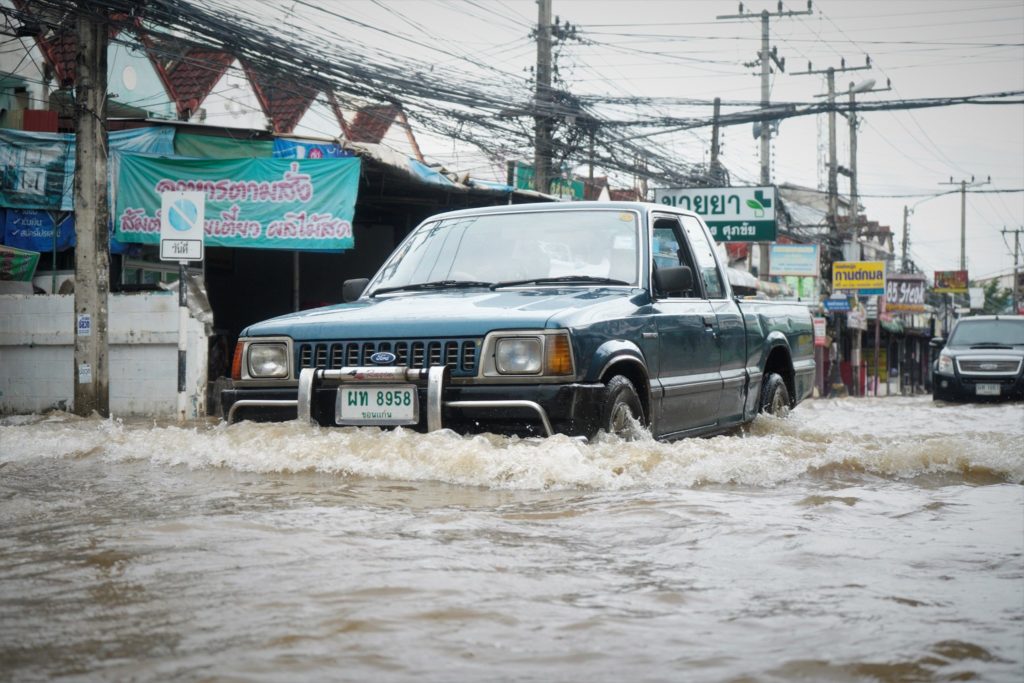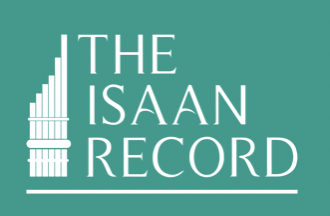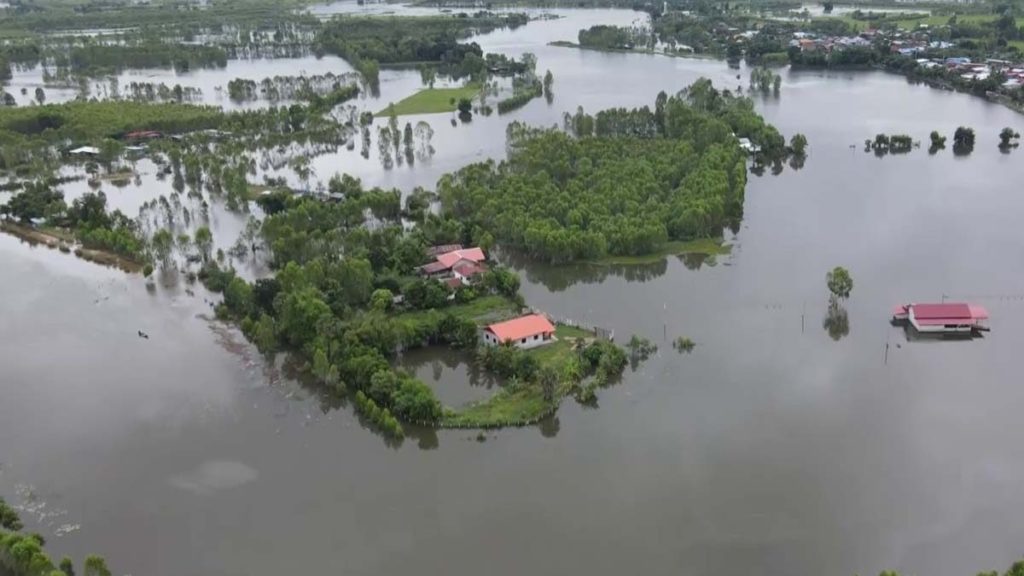
Heavy and persistent rain during the month of October—partially caused by tropical storms Dianmu and Kompasu—brought severe flooding to both central and northeastern Thailand, causing rivers to overflow their banks. According to the Department of Disaster Prevention and Mitigation, nearly half of Thailand’s 76 provinces have been affected by the monsoon-related flooding. Between late September and late October, more than 14,300 kilometers and more than 1.4 million people were affected, according to the Thailand Flood Monitoring Dashboard, created by the Geo-Informatics and Space Technology Development Agency. The flooding has impacted over 300,000 households and caused the deaths of 14 people. By mid-October, flooding had spread to many agricultural areas of Maha Sarakham, Nakhon Ratchasima, Surin, Buriram, Khon Kaen, and Chaiyaphum provinces, covering more than 1.2 million rai (1,900 sq. kms). While much of the flooding in many Thai provinces has been resolved, there are a handful of areas where monitoring is still taking place, particularly in Nakhon Ratchasima, Chaiyaphum, Lop Buri, and Nakhon Sawan.
Climate change and the expansion of settlements along floodplains have increased the dangers of flooding in Thailand, evidenced recently in 2011, when 65 provinces were affected and more than 23 billion baht in damages (almost 700 million USD). As Thailand works to mitigate the intense flooding in many cities and towns, a two-fold problem has emerged: a twin crisis of personal irresponsibility and poor disaster mitigation strategies on the national level.

National failures are complex. One of the biggest detriments to local communities and businesses during the 2011 floods was the lack of an early warning system and several failures in post-disaster recovery. Thai Prime Minister Prayut Chan-o-cha has recently admitted that the government has failed to address Thailand’s seasonal flooding problems, offering only “quick compensation” as relief to stressed locals. Often locals will reflect upon the late-King Bhumibol Adulyadej’s novel water management projects, including his idea of building “monkey cheeks”to store excess water. These innovations, years after his death, are either still missing in some areas or are just getting underway in others.
While national problems are sometimes difficult to pinpoint, the individual causes are much easier to recognize. Several examples help illustrate this point. In Chiang Mai, local officials were forced to issue a public appeal when the accumulation of public garbage inundated the city’s drainage system, which was clogged with plastic debris and other forms of synthetic waste, particularly at the Mae Kha Canal. In 2017, Chiang Mai had dredged the canal for flood mitigation purposes, clearing it of large pieces of garbage, including mattresses (which were stuffed with coconut husks for cleaning dirty water), household furniture and automobile parts. Officials called for common sense and simple solutions, such as the disposal of waste in bins at service points.
In September, Chaiyaphum faced similar problems, as flooding was exacerbated by an inability to drain water along municipal roads. Efforts to clear waterways were compromised by local residents, who illegally dumped their trash, which collected in the sewers and slowed drainage. Like in Chiang Mai, officials implored locals to recognize the impact of illegal dumping of trash on flood mitigation efforts.

A similar situation developed in Buriram, where heavy rain storms caused flooding on several key roads in the municipality. Water reached 30 centimeters high, flooding the entrance to the local bus terminal. The water overflowed the sewage system in part because the city drainage was clogged with debris and plastic bags. Buriram city’s mayor, Sakon Kraannapoom, ordered workers to expedite the drainage, and appealed to locals to not throw garbage and plastic bags on the streets, which eventually make their way into the drainage system.
A lack of knowledge about proper waste disposal is not limited to the rural Thai provinces, as Bangkok is also inundated with waste, as local communities, shophouses, and hawkers find little place to dump their garbage and often throw it into the city’s many canals. Bangkok in 2019 produced 10,000 tons of waste per day, a large share of the 27 million tons of waste produced in Thailand every year. The COVID-19 pandemic may have slowed waste somewhat in 2020, as there was a four percent decrease over 2019.
Thailand’s problem with waste is massive and grossly behind where it needs to be. Open dumping is the most prevalent garbage disposal method in Thailand, where out of a total of 425 sites for solid waste disposal, 330 of them were open dumps. It is the crudest method of waste disposal, where all kinds of waste—tires, batteries, chemicals, and household waste—is dumped in an open area within a community and sometimes set on fire. A 2014 report of the Pollution Control Department noted that of Thailand’s open trash pits, just a fraction are properly managed. Illegal forms of dumping contribute heavily to Thailand’s drainage control problems during heavy weather events, which are becoming more common as a result of climate change.
Casual dumping is also a major problem and part of it is cultural. Thailand’s food culture is synonymous now with plastic waste, where millions of people who consume its famous street food daily are served those meals in plastic bags or containers. Where once upon a time, they were elegantly wrapped in banana leaves and casually disposed of, this has been replaced by single-use plastics. This habit contributes to Thailand’s reputation as the sixth-worst maritime polluter, as 5,000 metric tons of plastic waste are generated daily.
While it is convenient to blame Thailand’s solid waste disposal problem on bad public policy, the reality is that the bulk of the problem rests with the consumer. Part of it is a lack of education. For example, few Thai people have the required knowledge to practice recycling or how individual actions can help mitigate natural disasters through proper waste management. The private sector, namely CP, the operator of 7-Eleven convenience stores, announced in 2018 that they would work to eliminate the use of single-use plastics at all of their stores.
More is needed. While it is politically expedient to blame plastic manufacturers or antiquated water management systems, consumers share a sizable portion of the blame in Thailand’s convenience-driven society. Education about recycling plastics should be the target of lawmakers both in public schools and at the local levels.
Thailand has an ambitious roadmap to curb plastic waste by 2030 and the military-backed government has been aggressive in its plans to dispose of solid waste. The Ministry of Natural Resources and Environment said that in 2020 it reduced the number of plastic bags by two billion or almost 6,000 tons in the first phase of a campaign to encourage consumers not to use plastic bags from convenience stores, supermarkets, and shopping malls. Rural areas and open markets still remain a problem.
Waste management is expensive. Bangkok alone spent nearly 7.5 billion baht on waste management in 2020, and Chiang Mai, which produces 300 tons of waste per day, spends 200 million baht on waste disposal per year?. Waste management is an increasingly burdensome and expensive task for Thailand’s cities, towns, and villages.
While the government needs to vastly improve the methods by which Thai consumers recycle their household waste nationwide and markedly increase collection points for plastic waste, consumers have to be educated about the consequences of their behaviors, which show up in the generation of environmental problems at open dumping and landfill sites, but also in the clogged canals and sewer systems throughout the country during the monsoon season.






